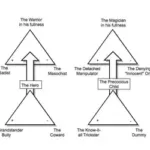 In the tantric tradition everything hinges on the polarity between the divine masculine, awareness and consciousness and the divine feminine, energy and life force. Everywhere we look we see this polarity between the outward and inward movement, the tension between the two. This is reflected in the Taoist tradition and we see it in pagan religions too. But how does this come across in a Christian context?
In the tantric tradition everything hinges on the polarity between the divine masculine, awareness and consciousness and the divine feminine, energy and life force. Everywhere we look we see this polarity between the outward and inward movement, the tension between the two. This is reflected in the Taoist tradition and we see it in pagan religions too. But how does this come across in a Christian context?
It seems that the Christian faith has for millennia tried to hide or deny the divine feminine either overtly or covertly. The whole idea of monotheism is that there is only one divine source (this monotheistic idea is also mirrored in the taoist, buddhist and hindu traditions as the source of this polarised duality). Duality simply isn’t part of the Christian equation. And yet it is there hidden in plain sight.
Already in the first book of the Judeo-Christian scriptures: Genesis, we can sense the presence of a duality as the ultimate consciousness is present above the deep waters (Mayim) and how the creator draws the substance of creation out of the depths in evocative theoerotic language.
The scriptures keep interchanging the divine masculine and feminine in reference to the divine. Starting with El-Shaddai the name of god that is translated as the almighty but scholars say that the name may also mean “God, the one with the large breasts” atom,opting to draw the picture of god as the one who weens and nurtures us. In the beautiful Swedish hymn, Lina Sandell describes god as “him that carries for me a mothers heart”.
One of the most used adjectives for god is the compassionate god which in the original language means god that cares for us like one carried in gods womb. Or to use Marcus Borgs phrase, the wombishness of god.
When god’s glory is described in the Jewish scriptures the term is shekina, which is another feminine attribute. Not to mention the wisdom of god chokmah or the Greek equivalent from the septuagint, Sophia. A name that is later alluded to Jesus in the first stanzas of John’s cosmic opening of his gospel.
Back in genesis, the feminine is called ezer kanegdo, which has been translated with the english term “helpmeet” which quickly leads us down the chauvinistic picture of women as secretaries who’s only skill is making coffee or typing memos. However the term ezer is more akin to life saver and is used as an attribute of god in the rest of the scriptures. Ever really means power or energy, so according to the biblical narrative the feminine is the power of god.
Tying these bits together we see a picture emerging of the divine feminine, the glory of god, the wisdom of god, the power of god. Which is very close to the tantric notion of shakti. The Catholic church tried to narrow the divine feminine down to the Madonna, the mother of god. In the Lutheran tradition even this image was erased and the holy spirit was neutered leaving only the overt image of the masculine of the divine for the church to worship. Underneath the male language, underneath the deliberate attempt of the patriarchs to subdue, tame and erase the divine feminine from the faith, underneath lies the bubbling strength of the waters, the undulating spirit that never rests and always transforms, that saturates our world with life-giving force and nurturing love. Try as we might to make god masculine the feminine was always there always under the surface.
As I hinted at in my last blog post about the divine masculine I think that while we overtly paint god as a man, covertly we have ascribed god all the mature feminine qualities. The ones still holding on to the masculine image have been left behind stuck with the immature masculine image of a vengeful, capricious deity not really worthy of worship. or as my friend Josh wrote in a resent blog post:
if we read it plainly and literally, that God is not omniscient, he is petty and childish, makes frequent mistakes, doesn’t care about women and is (and I can say this because I don’t actually believe the god I am describing here actually exists) a total idiot. The god revealed by a literalist reading of scripture is a clown; virtually useless and vastly irresponsible. He is a cosmic Mr Bean; tragically self-centred, and, actually, not a very nice person. Yes, he’s quite funny to watch as he makes his catastrophic mistakes (for example, trying to match Adam with and antelope for a life partner) but, in reality, you wouldn’t want anything to do with someone that fickle and stupid. To reduce the one true, almighty, all powerful, loving God to the level required of him in a literalist reading of the Bible is blasphemous and idolatrous.
When we stick to the surface image painted by the patriarchy and bible redactors we are left to this “cosmic Mr Bean”. But if we dare to scrape the surface we find the depths of the Mayim, the Tehomic waters of chaotic, virile, life giving, life force. In the beautiful dance of the trinity we see the divine masculine and the divine feminine in constant motion, in a evocative dance of sacred union. When we erase or deny, the sacred feminine we also lose the truly sacred masculine and we are left with a caricature that will generate division instead of unity; Caricature instead of the divine source of love in which image we are created.








